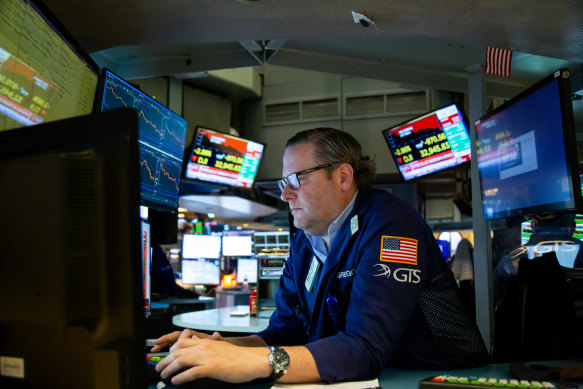ASX falls as Wall Street slides to wrap up an unhappy month
By Millie Muroi
The Australian sharemarket dipped on Wednesday as all sectors except materials, energy and utilities traded in the red and Wall Street closed lower overnight.
The S&P/ASX 200 was down 10.5 points, or 0.1 per cent, to 7247.9 about midday, weighed down by the communication services and real estate sectors.

Pilbara Minerals (up 3.8 per cent), Newcrest Mining (up 2.8 per cent) and BlueScope Steel (up 2.3 per cent) led gains, amid a broader lift in the materials sector (up 1.2 per cent). Heavyweights BHP (up 1.4 per cent) and Fortescue (up 1.4 per cent) also helped to buoy the index.
Communication services (down 1.7 per cent), real estate (down 1.6 per cent) and industrials (down 0.9 per cent) weighed down the ASX, as toll road developer Atlas Arteria (down 3.1 per cent) and TPG Telecom (down 1.6 per cent) sank. WiseTech and IDP Education also dropped, shedding 2.8 per cent and 2.4 per cent each.
More broadly, Australian economic growth slowed to 0.5 per cent in the December quarter, according to the latest gross domestic product figures released by the Australian Bureau of Statistics on Wednesday. That’s a second consecutive quarter of slowing growth, and failed to meet expectations of a 0.8 per cent increase, bringing economic growth in 2022 to 2.7 per cent.
ABS head of national accounts Katherine Keenan said consumption and exports were the major drivers of GDP growth.
“Continued growth in household and government spending drove the rise in consumption, while increased exports of travel services and continued overseas demand for coal and mineral ores drove exports,” she said.
At the same time, domestic prices grew strongly, up 1.4 per cent for the quarter and 6.6 per cent through the year. It’s the strongest annual growth in domestic prices since the March quarter of 1990, and confirms that inflation outpaced economic growth last year.
Meanwhile, a frigid February for Wall Street closed out with more losses.
The S&P 500 fell 0.3 per cent to lock in a loss of 2.6 per cent for the month. The Dow Jones Industrial Average fell 232 points, or 0.7 per cent, while the Nasdaq composite slipped 0.1 per cent. Both also sank over the month.
The Dow Jones was hurt by a 3.8 per cent fall for Goldman Sachs after chief executive David Solomon said the bank was considering “strategic alternatives” for its consumer business.
After a strong start to the year bolstered by hopes that inflation was on the way down, Wall Street shifted into reverse in February. A stream of data showed inflation and the overall economy were remaining more resilient than expected. That’s forced investors to raise their forecasts for how high the US Federal Reserve will take interest rates and how long it will keep them there.
High rates can drive down inflation, but they also raise the risk of a recession down the line because they hurt the economy. They also drag on prices for stocks and other investments.
After earlier this year hoping that the Fed could soon pause its aggressive hikes to interest rates, and maybe even begin cutting them late this year, traders have come around to believe the Fed’s long insistence that it plans to take rates higher for longer to ensure the job is done on inflation.
The Fed has said it wants rates to climb to a “sufficiently restrictive” level where the economy slows enough to get inflation down to its 2 per cent goal.
“Everything is sort of churning,” said Thomas Martin, senior portfolio manager at Globalt Investments. “Right now, the economy is doing fairly well, but earnings estimates for 2023 for the S&P 500 are continuing to drift lower. So you’re still moving in a softening direction. It’s just: how close do you get to the ground?”
He has raised his forecast for how high the Fed will ultimately raise rates, but he also said it was difficult to feel a great amount of certainty given all the push and pull.
“What everyone’s hoping for is that they are restrictive but not destructive,” Martin said of the Fed and rate rises. “Where we end up, there’s just a wide range of outcomes.”
Now the S&P 500 is hanging onto a gain of 3.4 per cent for the year.
Reports on the economy released on Tuesday showed some slight cracks. One said that confidence among US consumers unexpectedly fell in February. Another said that manufacturing in the Chicago region weakened by more than expected.
Most companies have already reported their results for the last three months of 2022, but several big-name retailers are still on the schedule for this week.
With AP
Most Viewed in Business
Source: Thanks smh.com